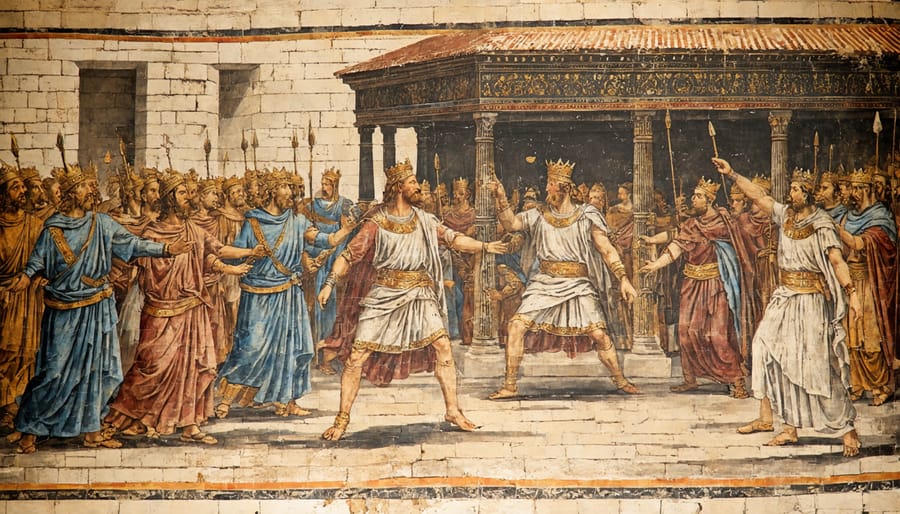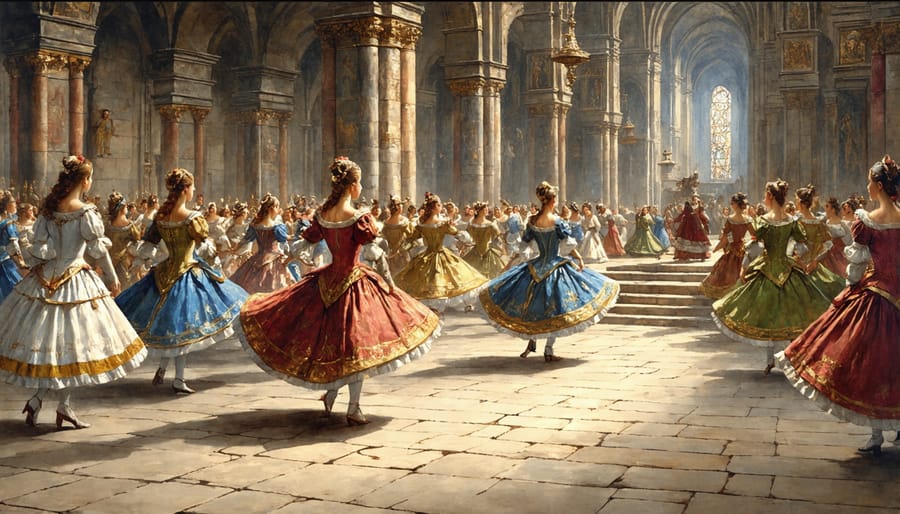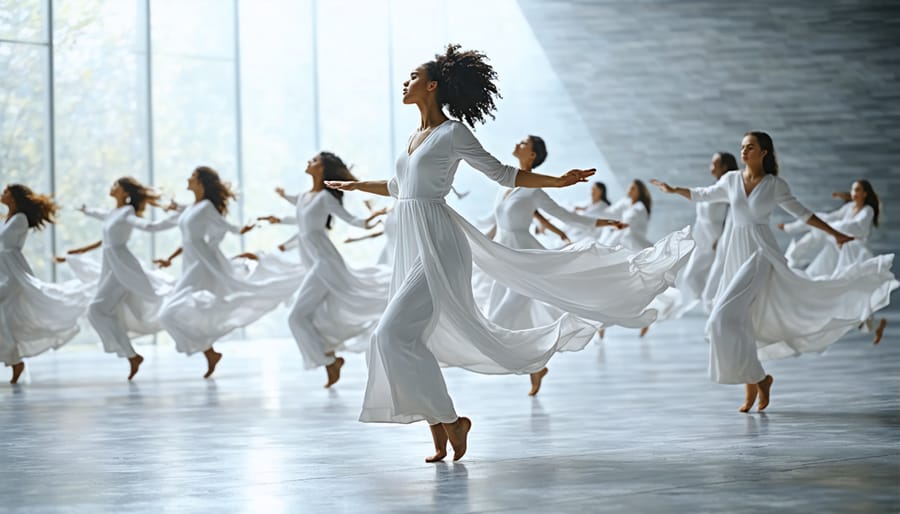Dance has served as a profound expression of worship since ancient times, weaving a sacred tapestry through biblical history and Christian tradition. From Miriam’s celebratory dance after the Exodus to David’s exuberant praise before the Ark of the Covenant, movement has embodied humanity’s deepest spiritual longings. The spiritual significance of liturgical dance emerged in early Christian communities, where sacred movement became a vital component of worship celebrations. Through medieval European monasteries, African Christian traditions, and modern revival movements, liturgical dance has evolved while maintaining its core purpose: offering embodied praise to God. Today, this ancient practice continues to flourish across denominations, inviting worshippers to express their faith through graceful movement that bridges heaven and earth, connecting contemporary believers with a rich heritage of physical devotion that spans millennia.
Biblical Foundations of Sacred Dance
Dance in the Old Testament
Dance as an expression of worship appears prominently throughout the Old Testament, often marking moments of divine celebration and spiritual victory. After crossing the Red Sea, Miriam led the women of Israel in dance with tambourines, praising God for their deliverance from Egypt (Exodus 15:20-21). This joyful celebration established an early biblical precedent for dance as a form of worship.
King David, known for his passionate worship, danced before the Lord with all his might when bringing the Ark of the Covenant to Jerusalem (2 Samuel 6:14-15). Despite criticism from his wife Michal, David remained steadfast in his expression of joy through dance, declaring that he would become even more undignified in his praise to God.
The Psalms also frequently mention dance as a legitimate form of worship, with verses like “Praise him with tambourine and dance” (Psalm 150:4) encouraging believers to express their devotion through movement. These biblical accounts demonstrate that dance held a significant place in ancient Hebrew worship practices, serving as a physical expression of spiritual joy and thanksgiving.

New Testament Perspectives
Early Christian attitudes toward dance were complex and often reflected the tension between cultural practices and new religious identity. While some Church Fathers expressed concerns about dance due to its associations with pagan rituals and moral corruption, others recognized its potential for sacred expression. The Apostle Paul’s teachings emphasized worship “in spirit and in truth” (John 4:24), though he didn’t specifically address dance.
Early Christian communities likely incorporated some forms of reverent movement in their worship, particularly influenced by Jewish traditions. Historical records suggest that early Christians would sometimes join hands and move in circular patterns while singing hymns and psalms. However, as the Church sought to distinguish itself from surrounding pagan cultures, formal dance became less common in worship settings.
By the 4th century, church councils began addressing dance more directly, leading to various restrictions on dancing within sacred spaces. Despite these limitations, forms of liturgical movement continued in certain Christian traditions, especially during religious festivals and celebrations.
Early Church and Medieval Period
Early Christian Practices
The early Christian church embraced movement as an integral part of their sacred worship traditions, drawing inspiration from their Jewish heritage. Historical records and early church writings suggest that Christians incorporated circular dances, processionals, and gestural movements during their gatherings, particularly during celebrations of baptism and communion.
In the Acts of the Apostles, we find references to believers being filled with the Holy Spirit and expressing their joy through physical movement. Early church fathers, including Clement of Alexandria and Augustine of Hippo, wrote about the appropriate use of dance in worship, though they cautioned against excessive or inappropriate expressions.
The catacombs of Rome contain artwork depicting Christians engaging in dance-like movements during worship, suggesting that physical expression was a natural part of their devotional life. These early practices laid the foundation for what would later develop into more formalized liturgical dance, though the spontaneous, Spirit-led nature of these movements reflected the intimate relationship between the believers and their Creator.
Medieval Religious Dance
During the medieval period, liturgical dance experienced significant changes as the Christian church became more institutionalized. While early Christian worship incorporated joyful movement, the medieval church gradually restricted dance within sacred spaces. By the 9th century, religious authorities began viewing dance with increasing suspicion, concerned that it might lead to inappropriate behavior during worship.
However, some forms of sacred movement persisted, particularly in religious processions and mystery plays. The labyrinth walks at Chartres Cathedral, for example, became a form of moving meditation, allowing pilgrims to journey symbolically toward God. In some European monasteries, monks performed solemn, choreographed movements during Easter celebrations, known as the “tripudium” or “three-step dance.”
Despite official restrictions, common people continued to express their faith through movement, especially during religious festivals and saint’s days. The famous “Dancing Procession of Echternach” in Luxembourg, established in the 8th century and continuing to this day, demonstrates how medieval Christians found ways to maintain dance as a form of devotion. These practices laid the foundation for later developments in liturgical dance, showing how movement and worship remained intertwined even in times of institutional resistance.

Modern Revival and Contemporary Practice
20th Century Renaissance
The twentieth century witnessed a remarkable revival of liturgical dance across Christian denominations, reflecting a renewed understanding of worship’s holistic nature. This renaissance began in earnest during the 1930s when religious leaders started reconsidering the role of movement in expressing faith. Margaret Palmer Fisk, a pioneering figure in this revival, demonstrated how dance could enhance spiritual experiences within Protestant services.
The Second Vatican Council (1962-1965) played a pivotal role in this renaissance by encouraging more dynamic forms of worship. This openness to artistic expression within Catholic liturgical traditions inspired many congregations to incorporate sacred dance into their services.
Churches began establishing dance ministries, and Christian choreographers developed new forms of worship that respected traditional liturgical elements while embracing contemporary expression. Religious institutions, including seminaries and Christian colleges, started offering courses in liturgical dance, recognizing its value in worship and ministry.
This revival wasn’t limited to Western Christianity; African, Asian, and Latin American churches integrated their cultural dance traditions with Christian worship, creating rich, meaningful expressions of faith. By the century’s end, liturgical dance had become an accepted form of worship in many Christian communities, serving as a powerful tool for spiritual expression and community building.
Contemporary Expressions
Today, liturgical dance flourishes across various Christian denominations, enriching worship experiences through movement and artistic expression. Many contemporary churches incorporate dance ministries as integral parts of their worship services, particularly during special celebrations like Easter, Christmas, and other significant occasions in the Christian calendar.
Modern liturgical dance takes diverse forms, from interpretive solo performances to coordinated group presentations. Some congregations feature trained dancers who perform choreographed pieces to worship music, while others encourage participatory movement for the entire congregation. Contemporary expressions often blend traditional sacred dance elements with modern dance styles, creating a unique fusion that speaks to today’s worshippers.
In Catholic and Episcopal churches, liturgical dance frequently accompanies processionals, gospel presentations, and offertory periods. Protestant denominations, especially in charismatic and evangelical settings, may include spontaneous dance as part of praise and worship. African American churches have particularly rich traditions of incorporating dance into worship, often featuring powerful movements that express deep spiritual connection and joy.
Many churches now offer dance ministry programs that provide training and spiritual formation for dancers of all ages. These programs emphasize both technical skill and spiritual development, teaching participants to use their bodies as instruments of worship while maintaining reverence and purpose in their movement. This modern revival of liturgical dance continues to evolve, demonstrating how ancient practices can be meaningfully adapted for contemporary worship.

The Spiritual Impact of Liturgical Dance
Liturgical dance has a profound spiritual impact on both the dancers and the congregation, creating a sacred space where movement becomes prayer and worship takes on a deeply experiential dimension. Through the graceful motions and intentional gestures, dancers embody Scripture and spiritual truths, making the Word of God visible to all who witness their ministry.
Many participants in liturgical dance report feeling closer to God during their performances, describing it as a form of moving meditation that allows them to express their faith in ways that words alone cannot capture. The physical act of dancing becomes an offering of the whole self – body, mind, and spirit – in worship to the Lord, fulfilling the call to “present your bodies as a living sacrifice, holy and acceptable to God” (Romans 12:1).
The communal aspect of liturgical dance creates powerful moments of shared worship experience. As dancers move in harmony, they demonstrate the unity of the Body of Christ, while the congregation’s engagement with the performance creates a dynamic spiritual atmosphere. This collective experience often leads to deeper emotional connections with worship songs and Scripture passages, helping to cement spiritual truths in the hearts of all present.
Moreover, liturgical dance serves as a bridge between different worship styles and traditions, appealing to multiple learning styles and ways of experiencing God’s presence. For visual and kinesthetic learners, dance ministry provides a unique pathway to understanding biblical narratives and spiritual concepts. The physical expression of worship can be particularly meaningful for those who struggle to connect with traditional sermon formats or musical worship alone.
In many congregations, liturgical dance has become a vital ministry tool for spiritual formation, particularly among youth and young adults who find in it a relevant and authentic way to express their faith. The discipline required for dance ministry also cultivates important spiritual fruits such as patience, perseverance, and humility, contributing to the personal spiritual growth of the dancers themselves.
Liturgical dance continues to be a powerful expression of worship, bridging ancient traditions with contemporary Christian expression. As churches worldwide embrace diverse forms of worship, dance remains a meaningful way to embody scripture, express devotion, and unite congregations in praise. Its enduring presence reminds us that worship encompasses our whole being – body, mind, and spirit – just as King David demonstrated in his zealous dance before the Lord. Looking ahead, liturgical dance holds promise for engaging younger generations, fostering inclusive worship experiences, and helping believers connect with God in deeply personal ways. Whether through traditional sacred movement or modern interpretative dance, this art form continues to fulfill its divine purpose: glorifying God and edifying the body of Christ. As we move forward, may we remain open to how the Holy Spirit leads us to worship, remembering that dance has been and will continue to be a beautiful offering of praise to our Creator.
